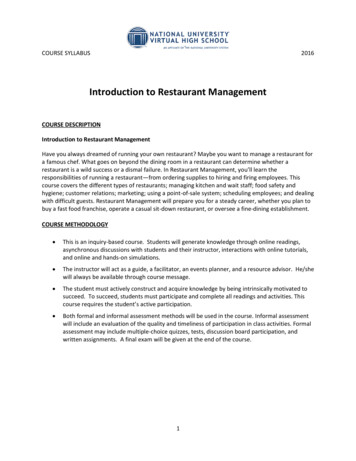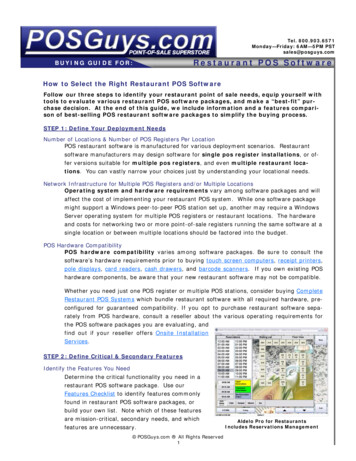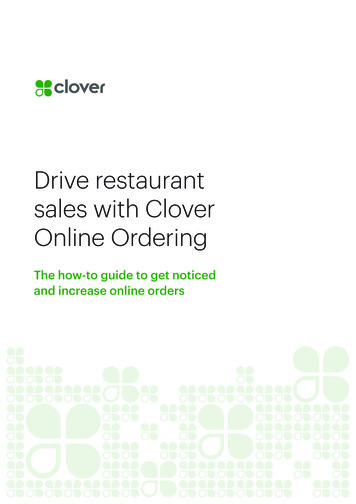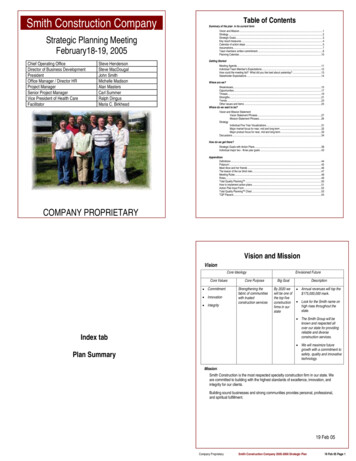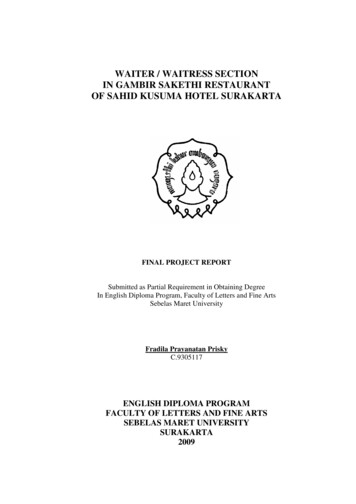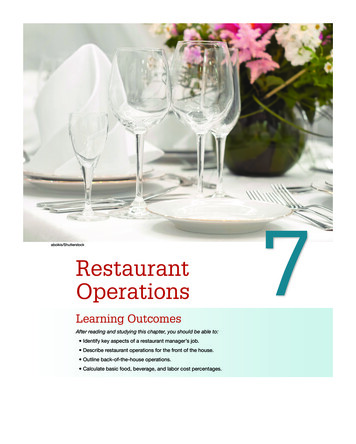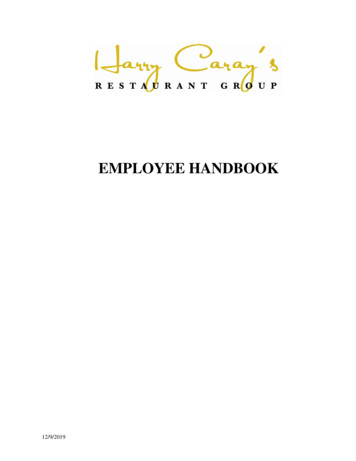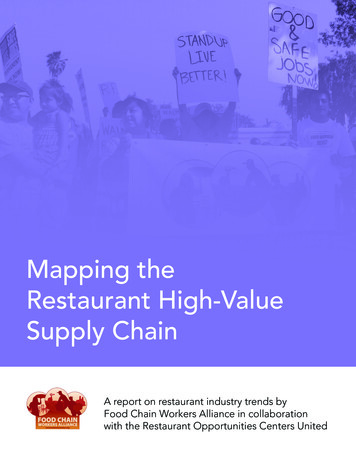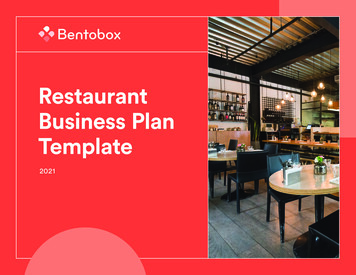
Transcription
RestaurantBusiness PlanTemplate2021
The restaurant business plan is a crucial firststep in turning an idea for a restaurant intoan actual business. Without it, investors andlenders will have no way of knowing if thebusiness is feasible or when the restaurantwill become profitable. Business plans spandozens (or even hundreds) of pages, and dueto the stakes that lie within the documentand the work required to write it, the processof writing a restaurant business plan canthreaten to overwhelm.That’s why BentoBox has created a restaurantbusiness plan template for aspiring restaurantowners. This template makes creating abusiness plan easier with section promptsfor business plan essentials like financialprojections, market analysis and a restaurantoperations overview.Download the TemplateRestaurant Business Plan2
Table of ContentsExecutive Summary04Leadership Team05Restaurant Business Overview06Industry & Market Analysis07Marketing Strategy08Operating Model09Financial Overview & Projections11Appendix & Supporting Documentation12Business Plan Glossary13Restaurant Business Plan3
Executive SummaryThe executive summary provides a 1-2 page overview of therestaurant and its business model. While the details of howthe restaurant will succeed will be explained throughout thisbusiness plan, this section will both prove the legitimacyof the restaurant idea while encouraging investors toenthusiastically read through the rest of the plan.OVERVIEWSome specific topics that might be covered in theexecutive summary include: Restaurant name, service type and menu overview. A quick mention of why the leader of the restaurantbusiness is positioned to help it succeed. A brief overview of the restaurant’s competitiveadvantages and how they will help the business thrive inits target market. Expected break even point and sales forecasts forat least the first year.Restaurant Business Plan4
Leadership TeamThis section will introduce readers to the team that will run the restaurant. Some people who might beworth including here are the restaurant’s owner(s), other investors, franchise representatives, managersand/or back-of-house leaders.NameRole at company2-3 sentences explainingwho this person is andwhy they are a good fitfor this position.Restaurant Business Plan5
RestaurantBusiness OverviewThis section introduces the reader to the restaurant’sconcept. It should paint the picture of what potential guestscan expect when they walk through the door, pull up to thedrive-thru or place an order on the restaurant’s website.MISSION STATEMENTWhat is the restaurant’s mission? This section should boil down thepurpose of the restaurant’s existence in a catchy sentence or two.MENU & CUISINEThis section explains what kind of food will be sold at the restaurant,from the overall cuisine type to a few example dishes.SERVICE STYLEIs the restaurant full-service, fast-casual, drive-thru only or somecombination of these concepts? It should be explained why that conceptwas selected and – if unique – how the guest ordering process will work.Restaurant Business Plan6
Industry &Market AnalysisThis section compiles research that’s been done on the industry, the location the restaurant will occupy and those therestaurant will serve. The more detail provided in this section, the more valid the conclusions reached in the financialssection will appear to be.INDUSTRY OVERVIEWTARGET MARKETThe industry overview serves as a snapshot of the industry and whynow is the right time to open up a restaurant (and pursue the chosenrestaurant concept). Specific research to support these claims should beincluded and cited.Who will be the restaurant’s regular customers – office workers lookingfor a grab-and-go lunch or families of four looking for a meal after a longweek? This section should also estimate the size of the target market inthe area alongside any demographic information known about people inthat market.LOCATION OVERVIEWThis section provides an overview of the area chosen to be the home of therestaurant. Specifically, an explanation should be given for why the generalarea (and if known, the specific location) of the restaurant was selected.Also, it should be communicated here if an existing restaurant location isbeing purchased and – if so – whether or not it will be rebranded.COMPETITIVE LANDSCAPEThis section summarizes an analysis of the restaurant competition inthe area and how it will compete. Supporting documentation such asa SWOT analysis, a competitive matrix and/or a Porter’s Five ForcesAnalysis might go here (or in the appendix).Restaurant Business Plan7
Marketing StrategyThe marketing strategy section highlights whichmarketing channels will be used to appeal to therestaurant’s target market.BRAND POSITIONINGBefore explaining whether or not you’ll use Facebook, an overview ofthe restaurant’s brand positioning should be provided.Add strategies for the following outlets in this sectionif applicable.Public RelationsVideo MarketingSocial MediaNewspaper/MagazineDirect MailPaid Search MarketingWebsite MarketingEmail MarketingCommunity EngagementRestaurant Business Plan8
Operating ModelThe operating model section is for going over the logistics of running the business and showing readers that all thepieces are in place to efficiently and accurately fulfill orders – all while retaining staff, keeping the restaurant safeand breaking even as soon as possible.SERVICE MODELTARGET MARKETThe service model is the end-to-end experience of ordering at therestaurant in all of the different ways a guest will be able to (onlineordering, in-person dining, etc.). Specifically, staff touchpoints withguests in both the front and back of the house should be identified.This section should give an overview of both in-store restauranttechnology (such as a POS system) and any integrated software thathelps restaurants get discovered online, like a website or an onlineordering program.In this section, there should be a list of types of technology that willbe utilized to streamline operations in the restaurant, alongside anexplanation of how they will enhance the guest experience and whichtechnology providers the business will be partnering with.YESExamples of restaurant technology that might be highlighted in thissection include:Restaurant websitemanagementOnline ordering systemNOGift card managementOnline catering platformEvents management softwareDigital ordering & paymentDigital loyalty programRestaurant point-of-sale (POS)Inventory management softwareKitchen display screens (KDS)Payroll & HR softwareScheduling and employeeengagement softwareRestaurant Business Plan9
Operating ModelSTAFFING & HIRINGKITCHEN & BACK-OF-HOUSEWhat steps will be taken to hire, train and onboard a staff of restaurantprofessionals? This section could include recruiting tactics, a rundownof the interview process, safety and training procedures, retention playsand the target staff size upon open.This section should contain a walkthrough of the restaurant’skitchen operations strategy. Inventory management strategy,approach to food suppliers and a list of required kitchen tools andequipment should be covered.Restaurant Business Plan10
Financial Overview& ProjectionsAt the end of the day, investors need to know when and if the restaurant will be profitable. This section will providethem with that information.OPENING COST OVERVIEWPRO FORMA INCOME STATEMENTThis section should provide a thorough explanation of how much therestaurant will cost to open. It should be exhaustive so investors knowexactly where their money is going. If needed, a complete opening costoutline should be provided in the appendix.The business’s profit or loss during this early period should be projectedwith a pro forma income statement. It’s important to put as much work aspossible into this document to set realistic goals for investors based onresearch and quotes from vendors. Since the P&L statement will likely bea one-sheeter, it might make sense to briefly summarize the time periodand bottom line reflected in the document and to attach the full versionin the appendix.SALES FORECASTIncluded here should be a forecast of how much revenue the restaurantis projected to make. As a benchmark, this forecast should be providedfor the first twelve months of business and/or until the break even pointis reached. If needed, a more in-depth sales forecast broken down bymonth/quarter can be provided in the appendix.BREAK EVEN ANALYSISThe projected break even point in both dollars and number of days shouldbe declared in this section. Aim to be as objective as possible in theanalysis, as investors will likely pay close attention to what’s in this section.Restaurant Business Plan11
Appendix& SupportingDocumentsFLOORPLANSAny and all supporting documents referenced throughoutthe plan should be included in this section, including(but not limited to): Financial statements, graphs, tables, chartsand/or projections Photos or renderings of the restaurant locationMENU A sample menu Photos of the restaurant website and/or onlineordering platform Floor plans References from colleagues in the restaurant industryRestaurant Business Plan12
Business PlanGlossaryThis glossary explains some of the key terms used throughout this template. It can be kept as is, deleted if notneeded, or altered to add more terms that may need an explanation.BREAK EVENSWOT ANALYSISBreak even is the point in either time or dollars where a business earnsback all of the money it spent up until that point, after which it will beprofitable. The formula for calculating break even point in dollars (orsales) is explained here.A SWOT analysis explores the restaurant’s internal strengths andweaknesses and its external opportunities and threats. It outlines whatsuccess factors are in a business’s control, which ones are not and whatcan be done to help the restaurant compete. Learning how to build aSWOT analysis for a restaurant business can be done here.Break even point, in time, is determined by comparing sales forecastswith break even in dollars to estimate how long it will take for thebusiness to achieve that break even point.PRO FORMA INCOME STATEMENT (P&L STATEMENT)A pro forma income statement is a projected profit and loss (or P&L, forshort) statement. Based on sales and costs estimates, it shows whetheror not a business will be profitable at a set point in the future. Whenmaking a P&L statement for a business plan, it’s wise to project it for theexpected break even point so investors will know when they will see areturn on their investments. Projected pro forma income statements arefurther explored rant Business Plan13
Business PlanGlossaryCOMPETITIVE MATRIXPORTER’S FIVE FORCES ANALYSISA competitive matrix is used to visually compare a business to itscompetitors. There are several different kinds of competitive matrices,many of which are explained here.A Porter’s Five Forces Analysis explores five major forces in determininga business’s viability – buyer power, supplier power, competitive rivalry,the threat of substitution, and the threat of new entry into the industry.Ideally, the analysis will suggest that the restaurant doesn’t face manyexternal threats and is likely to succeed. Porter’s Five Forces is explainedmore in this article.Restaurant Business Plan14
Get more tipsand best practicesfrom BentoBoxVisit Beyond The Meal to read storiesdedicated to extending hospitality online,empowering restaurants everywhere.
Restaurant Business Plan 2 The restaurant business plan is a crucial first step in turning an idea for a restaurant into an actual business. Without it, investors and lenders will have no way of knowing if the business is feasible or when the restaurant will become profitable. Business plans span dozens (or even hundreds) of pages, and due
